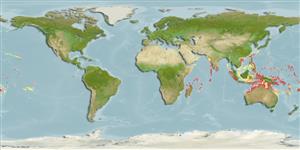>
Gobiiformes (Gobies) >
Gobiidae (Gobies) > Gobiinae
Etymology: Trimma: Greek, trimma, -atos = something crushed (Ref. 45335); anaima: Name from the Greek 'anaimos', meaning bloodless, pallid, pale or anaemic, referring to the pale, almost washed-out colouration of the species; noun in apposition (Ref. 100726).
More on author: Winterbottom.
Environment: milieu / climate zone / depth range / distribution range
Ekologi
laut dasar (demersal); kisaran kedalaman 3 - 35 m (Ref. 90102). Tropical
Indo-West Pacific: Comores, Maldive Islands; to Indonesia, Philippines, Caroline Islands, Papua New Guinea, Western Australia, and Fiji.
Size / Weight / umur
Maturity: Lm ? range ? - ? cm
Max length : 3.0 cm SL jantan/; (Ref. 48637)
Duri punggung (Keseluruhan (total)): 6 - 7; duri punggung lunak (Keseluruhan (total)): 8; Duri dubur 1; Sirip dubur lunak: 8. Distinguished by the following characters: a bony interorbital about 2/3 pupil diameter in width and only slightly concave; absence of troughs or trenches in the interorbital or posterodorsal orbital regions; unbranched fifth pelvic-fin ray, 50-60% fourth ray; epaxialis extending anteriorly to a vertical in line with the posterior margin of the orbit (Ref. 100726); no elongated spines; all pectoral rays unbranched; longitudinal scale series 23; absence of predorsal scales on midline; 1-2 deciduous scales on upper opercle; depth of body 4.0-4.1 in SL; semi-translucent pink on upper half of body (straw-yellow, translucent above midlateral septum, Ref. 100726); midlateral stripe is broad and reddish orange in color; breast and belly, white; narrow light blue lines below eye, dorsal midline of snout and behind upper rear corner of eye (Ref. 90102).
Inhabits coastal reef slopes and lagoons. Found along reef margins with rubble (Ref. 48637). Also found in caves and crevices, often on drop-offs in 3-35 m (Ref. 90102). A relatively rare species in collections, usually been taken in lots of one or two specimens (Ref. 100726)..
Life cycle and mating behavior
Kematangan | Reproduksi, perkembang biakan | Pemijahan | telur-telur | Fecundity | Larva
Winterbottom, R. and D.F. Hoese, 2015. A revision of the Australian species of Trimma (Actinopterygii, Gobiidae), with descriptions of six new species and redescriptions of twenty-three valid species. Zootaxa 3934(1):001-102. (Ref. 100726)
Status IUCN Red List (Ref. 130435)
ancaman kepada manusia
Harmless
penggunaan manusia
informasi lanjut
Nama-nama umumSinonim (persamaan)metabolismePemangsaEkotoksikologiReproduksi, perkembang biakanKematanganPemijahanSpawning aggregationFecunditytelur-telurpekembangan telor
AcuanBudidaya airprofil budidaya airStrainGenetikaElectrophoresesDiturunkanPenyakit-penyakitPengolahanNutrientsMass conversion
mitraGambarStamps, Coins Misc.Suara-suaraCiguateraKecepatanTipe renangArea insangOtolithsOtakPenglihatan / visi
Alat, peralatan
laporan khas
muat turun XML
Sumber internet
Estimates based on models
Preferred temperature (Ref.
123201): 26.3 - 28.9, mean 27.8 °C (based on 302 cells).
Phylogenetic diversity index (Ref.
82804): PD
50 = 0.5000 [Uniqueness, from 0.5 = low to 2.0 = high].
Bayesian length-weight: a=0.01023 (0.00477 - 0.02194), b=3.02 (2.84 - 3.20), in cm total length, based on LWR estimates for this (Sub)family-body shape (Ref.
93245).
Daya lenting (Ref.
120179): Tinggi, Waktu penggandaan populasi minimum kurang dari 15 bulan (Preliminary K or Fecundity.).
Fishing Vulnerability (Ref.
59153): Low vulnerability (10 of 100).
Nutrients (Ref.
124155): Calcium = 868 [367, 2,774] mg/100g; Iron = 2.64 [1.33, 5.75] mg/100g; Protein = 17.4 [15.4, 19.1] %; Omega3 = 0.284 [0.101, 0.699] g/100g; Selenium = 42 [16, 105] μg/100g; VitaminA = 36.4 [9.3, 133.8] μg/100g; Zinc = 3.5 [2.1, 5.7] mg/100g (wet weight);
